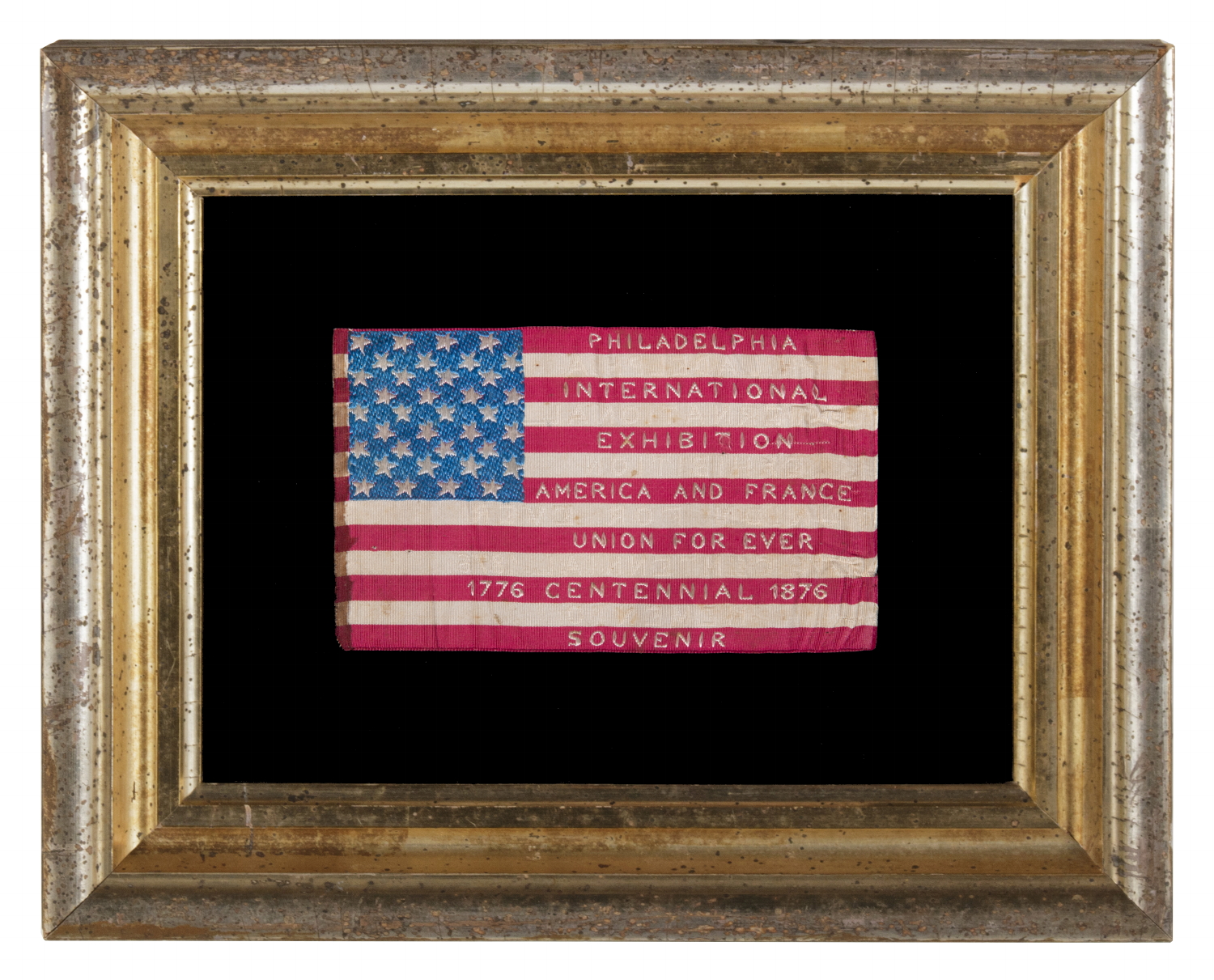
| |
EXTRAORDINARY SILK FLAG MADE FOR THE 1876 CENTENNIAL INTERNATIONAL EXPOSITION IN PHILADELPHIA, WITH WOVEN TEXT ON EITHER SIDE, PROBABLY MADE AT ONE OF THE FRENCH EXHIBITS AT THE FAIR AND SOLD AS A SOUVENIR |
|
| Available: |
Sold |
| Frame Size (H x L): |
Approx. 8.5" x 10.25" |
| Flag Size (H x L): |
3.75" x 4.75" |
|
| Description....: |
|
American national flag, made of silk, designed for the 1876 Centennial International Exposition in Philadelphia. This major World’s Fair event, held in Fairmont Park, lasted from May through November of that year, and served as the nucleus of the celebration of our nation’s 100th anniversary of independence.
The flag is woven in the manner of a Stevensgraph (a woven pictorial panel), a process new to the textile industry and no-doubt chosen to be shown off in the many displays of technological advancement that were the primary theme of the fair. The flag has 36 stars, which does not relate to its period of use, probably due to lack of French knowledge concerning the proper number of stars at the time, which was officially 37, though most flags-makers in America were producing examples with 38 or 39 stars.*
Woven onto the red stripes on one side of the flag is the following text: “Philadelphia International Exhibition; America and France; Union For Ever; Souvenir.” Woven into the white stripes on the reverse side is the following: “Philadelphia International Exhibition; Union For Ever; 1776 Centennial 1876; Memento.”
Though the name of the maker is not known, based upon my knowledge of other small woven textiles of this nature, produced and sold at the exposition, I think it very likely that the flag was actually made there, on site, as part of the French exhibit. One of the most significant reasons behind World’s Fair events was to showcase new technology. The ability to utilize modified versions of jacquard weave looms to produce textiles of this nature was a marvel of the time. Most of the pioneers in this field wove bookmarks, cloth postcards, and small, frameable, souvenir textiles. This is the only known variety of parade flag that I know of with this manner of construction. I also know of no other Stevensgraph-like textile that displays images or lettering on both sides of a single length of fabric.
These flags originally came on an unusually nice staff, varnished red, capped with a tiny brass finial. This was of very high quality when compared to almost all other parade flags of any period, most of which are affixed to a simple, unfinished wooden dowel. For some reason, the staffs of these woven silk flags are almost always absent.
* Colorado became the 38th state on August 1st, 1876. This was the year of our nation’s 100-year anniversary of independence. Per the Third Flag Act of 1818, stars were not officially added until the 4th of July following a state's addition. For this reason, 37 was the official star count for the American flag in 1876. Flag-making was a competitive venture, however, and almost no one followed the official guidelines, which the average American probably had no knowledge of anyway. Few flag-makers would have continued to produce 37 star flags, when their competitors were making 38’s to include Colorado. It is for this reason that flags with 38 and 13 stars (to represent the original 13 colonies) are far and away more commonly encountered on flags made for the centennial. Some flag-makers would have been adding a star for the 38th state even before it entered the Union, in the early part of 1876 or even prior. In fact, many makers of parade flags were actually producing 39 star flags, in hopeful anticipation of the addition of two more Western Territories instead of one.
Mounting: The flag was mounted and framed in our own conservation department, which is led by expert staff. We take great care in the mounting and preservation of flags and have framed thousands of examples.
The gilded molding dates to the period between 1830 and 1850. The background is black cotton twill. Spacers keep the textile away from the glass, which is U.V. protective.
Condition: There is very minor foxing and staining throughout the body of the flag, accompanied by more significant discoloration along the hoist end, where the flag was once affixed to a wooden staff. There are tint tears along the hoist end between the 3rd and 4th stripes and between the 10th and 11th stripes. The colors and overall condition are excellent when compared to most surviving examples. |
|
|
|
| Collector Level: |
Intermediate-Level Collectors and Special Gifts |
|
| Flag Type: |
Parade flag |
|
| Star Count: |
36 |
|
| Earliest Date of Origin: |
1876 |
|
| Latest Date of Origin: |
1876 |
|
| State/Affiliation: |
Nevada |
|
| War Association: |
|
|
| Price: |
SOLD |
|
| |
Views: 382 |
|
|
|

